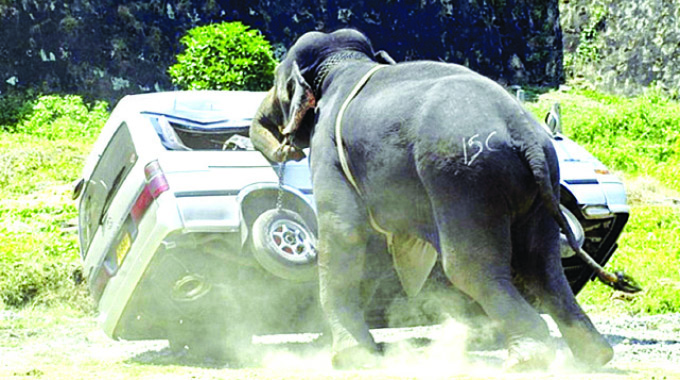Source: Promote innovative solutions to human-wildlife conflicts | The Herald
Mahlabezulu Zulu Correspondent
Instead of waiting for the crop growing season to educate communities on ways of controlling wild animals, some wildlife conservation organisations have prioritised conducting human and wildlife conflict educational programmes for their respective target groups throughout the year.
DIFFERENT versions of human and wildlife conflict have been experienced, and possible solutions proffered.
On some occasions, humans have had unexpected experiences with wild animals during visits, or in communities neighbouring wildlife-protected areas.
Road signs have been vandalised, leaking water pipes dug out and destroyed by elephants, community’s livestock killed or fields invaded and crops destroyed.
Human and wildlife conflict normally reaches its peak when communities sharing borders with wildlife protected areas start tilling land for crop production during the rainy season.
It’s unfortunate that different stages of crop production are sometimes marked by different versions of human and wildlife conflict.
Depending on common wildlife species found in the areas, some communities might be unlucky to experience this conflict at an early stage, for example, guinea fowls, baboons or rodents spotting and digging the seeds which would have just been sown, other herbivorous animals cutting down plants at different stages up to the invasion of bigger animals like elephants.
Besides feeding on the plants which are grown in the fields, elephants’ walk through fields destroys crops.
Having realised that these wild animals have caused a lot of damage, it’s good that some wildlife conservation projects have pulled out useful knowledge deposited in different sources about certain species of animals, that is, the knowledge on the response of certain animals when exposed to certain conditions and these have been used as “tools” of cultivating better relationships between human beings and wild animals.
Application of animal psychological studies has proved useful, and are used as a major tool.
It’s good that wildlife conservation projects and concerned stakeholders have engaged themselves minimising these conflicts.
Elephants, being the biggest mammal on the land, gobbles up much from the farmers’ crops.
Crop destruction is seasonal, especially with most rain-fed field crops.
Instead of waiting for the crop growing season to educate communities on ways of controlling wild animals, some wildlife conservation organisations have prioritised conducting human and wildlife conflict educational programmes for their respective target groups throughout the year.
Use of humane techniques like burning of chilli mixed with elephant dung, planting chilli around the fields or use of a chilli gun to spread irritating chilli particles in the air — all techniques undertaken, and involve use of chilli take advantage of the irritative nature of chilli in the eyes, nose or sometimes on the mouth of an animal being controlled.
Use of beehives placed around the field’s boundary has also become popular in controlling elephants, and safeguarding crop fields.
To ensure that the target groups grasp the concepts about the use of such humane techniques, organisations conduct lessons or workshops to impart knowledge about the techniques to schoolchildren or communities.
While this is beneficial to both human beings, and wild animals and greatly appreciated, it is best for the concerned conservation organisations promoting use of such techniques to sometimes work hand in glove with communities to apply such techniques right from the start of the cropping season up to harvesting.
Participation by such organisations has many advantages which include, good timing and early application of the technique, correct design and use of the technique.
In most cases with the onset of rains, most communal farmers tend to be busy in tilling, weeding their fields and they always shelve other important operations, provision of relevant resources which the farmers might not have, for example, the chilli gun or vehicle to use to cover a wide area during the application of the techniques is important.
Sometimes it’s wise to apply some of these techniques at communal level instead of individual field level, hence the need of such resources like vehicles.
Because of the valid stated advantages of active participation by relevant organisations implementing these humane techniques of solving human and wildlife, it’s unfortunate that when the cropping season comes all is left to the farmer who might not have enough resources.
Only a handful of organisations have gone into active participation during this period.
One such organisation is Elephant CREW (Community, Research, Education and Welfare) project which is in Victoria Falls.
The elephant project runs research, schools and communities educational and field work programmes to promote understanding of elephants as common species living in protected areas.
The project has trained personnel who make yearly visits, and assist communities in using humane techniques to control elephants during the cropping season.
Due to the early response by the team, and active participation by communities, this has yielded better results as most fields have been spared from elephant destruction.
Monicah Maboke, the community conservation manager said, “Knowing that farmers might have challenges with elephants which invade their fields from the neighbouring Fuller Forestry and Matetsi National Park Unit 1 prior to onset of rains, we always make arrangements with local leadership, and the community on how we can implement the humane techniques as a project.
“Once the rainy season starts, farmers will be busy hence they need such help.”
Elephant CREW project assists Sikabela, Masuwe and Woodlands communities which share borders with wildlife protected areas.
These communities also have conservancies which offer hunting concessions for the benefit of communities.
Some of the wild animals especially elephants have been killed under Problem Animal Control (PAC) when they are reported to authorities, for example, ZimParks that they have caused havoc in the fields.
Knowing that we also need these animals for tourism-related benefits, communities should be groomed and supported in using humane techniques to safeguard their fields or livestock to avoid killing of certain species of wild animals. — Bulawayo Bureau
Mahlabezulu Zulu is a conservationist who has worked for various wildlife research, and conservation organisations in Hwange National Parks and Fuller Forestry in Victoria Falls.

COMMENTS